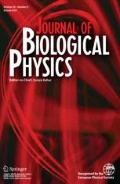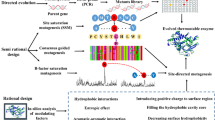Abstract
Triosephosphate isomerase (TIM) is often described as a fully evolved housekeeping enzyme with near-maximal possible reaction rate. The assumption that an enzyme is perfectly evolved has not been easy to confirm or refute. In this paper, we use maximization of entropy production within known constraints to examine this assumption by calculating steady-state cyclic flux, corresponding entropy production, and catalytic activity in a reversible four-state scheme of TIM functional states. The maximal entropy production (MaxEP) requirement for any of the first three transitions between TIM functional states leads to decreased total entropy production. Only the MaxEP requirement for the product (R-glyceraldehyde-3-phosphate) release step led to a 30% increase in enzyme activity, specificity constant kcat/KM, and overall entropy production. The product release step, due to the TIM molecular machine working in the physiological direction of glycolysis, has not been identified before as the rate-limiting step by using irreversible thermodynamics. Together with structural studies, our results open the possibility for finding amino acid substitutions leading to an increased frequency of loop six opening and product release.




Similar content being viewed by others
Abbreviations
- TIM:
-
Triosephosphate isomerase
- DHAP:
-
Dihydroxyacetone phosphate
- GAP:
-
d-glyceraldehyde 3-phosphate
- MaxEP:
-
Maximum entropy production
References
Cooper, G.M.: The Cell: a Molecular Approach. The central role of enzymes as biological catalysts. 2nd edition, Sunderland (MA): Sinauer Associates. (2000) http://www.ncbi.nlm.nih.gov/books/NBK9921/
Heinrich, R., Schuster, S., Holzhütter, H.-G.: Mathematical analysis of enzymic reaction systems using optimization principles. Eur. J. Biochem. 201, 1–21 (1991)
Marin-Sanguino, A., Torres, N.: Modeling, steady state analysis and optimization of the catalytic efficiency of the triosephosphate isomerase. Bull. Math. Biol. 64(2), 301–326 (2002)
Dobovišek, A., Županović, P., Brumen, M., Juretić, D.: Maximum entropy production and maximum Shannon entropy as germane principles for the evolution of enzyme kinetics. In: Dewar, R.C., Lineweaver, C.H., Niven, R.K., Regenauer-Lieb, K. (eds.) Beyond the Second Law, pp. 361–382. Springer, Berlin (2014)
Albery, W.J., Knowles, J.R.: Evolution of enzyme function and the development of catalytic efficiency. Biochemistry 15, 5631–5640 (1976)
Wierenga, R.K., Kapetaniou, E.G., Venkatesan, R.: Triophosphate isomerase: a highly evolved biocatalyst. Cell. Mol. Life. Sci. 67, 3961–3982 (2010)
Hill, T.L.: Free Energy Transduction and Biochemical Cycle Kinetics. Dover Publications, Inc. (2005)
Prigogine, I.: Introduction to Thermodynamics of Irreversible Processes. Wiley, New York (1967)
Kleidon, A., Lorenz, R.D.: Non-equilibrium Thermodynamics and the Production of Entropy: Life, Earth, and Beyond. Springer, Berlin (2005)
Martyushev, L.M., Seleznev, V.D.: Maximum entropy production principle in physics, chemistry and biology. Phys. Rep. 426, 1–45 (2006)
Martyushev, L.M., Seleznev, V.D.: The restrictions of the maximum entropy production principle. Phys A: Stat. Mech. Appl. 410, 17–21 (2014)
Dobovišek, A., Županović, P., Brumen, M., Bonačić-Lošić, Ž., Kuić, D., Juretić, D.: Enzyme kinetics and the maximum entropy production principle. Biophys. Chem. 154, 49–55 (2011)
Juretić, D., Županović, P.: Photosynthetic models with maximum entropy production in irreversible charge transfer steps. J. Comp. Biol. Chem. 27, 541–553 (2003)
Dewar, R.C., Juretić, D., Županović, P.: The functional design of the rotary enzyme ATP synthase is consistent with maximum entropy production. Chem. Phys. Lett. 430, 177–182 (2006)
Knowles, J.R., Albery, W.J.: Perfection in enzyme catalysis: the energetics of triosephosphate isomerase. Acc. Chem. Res. 10, 105–111 (1977)
Daar, I.O., Artymuik, P.J., Phillips, D.C., Maquat, L.E.: Human triose-phosphate isomerase deficiency: a single amino acid substitution leads in a thermolabile enzyme. Proc. Natl. Acad. Sci. U. S. A. 83, 7903–7907 (1986)
Williams, J.C., Zeelen, J.P., Neubauer, G., Vriend, G., Backmann, J., Michels, P.A.M., Lambeir, A.-M., Wierenga, R.K.: Structural and mutagenesis studies of leishmania triosephosphate isomerase: a point mutation can convert a mesophilic enzyme into a superstable enzyme without losing catalytic power. Protein Eng. 12, 243–250 (1999)
Hill, T.L.: Free Energy Transduction in Biology. The Steady State Kinetic and Thermodynamic Formalism. Academic Press, New York (1977)
Rozovsky, S., McDermott, A.E.: Substrate product equilibrium on a reversible enzyme triosephosphate isomerase. Proc. Natl. Acad. Sci. U. S. A. 104, 2080–2085 (2007)
Eisenthal, R., Danson, M.J., Hough, D.W.: Catalytic efficiency and kcat/KM: useful comparator? Trends in Biotechnology 25(6), 247–249 (2007). doi:10.1016/j.tibtech.2007.03.010
Johnson, K.A.: Transient-state kinetic analysis of enzyme reaction pathways. Enzymes 20, 1–61 (1992)
Pettersson, G.: Evolutionary optimization of the catalytic efficiency of enzymes. Eur. J. Biochem. 206, 289–295 (1992)
Dewar, R.C., Maritan, A.: A theoretical basis for maximum entropy production. In: Dewar, R.C., Lineweaver, C.H., Niven, R.K., Regenauer-Lieb, K. (eds.) Beyond the Second Law, pp. 49–71. Springer, Berlin (2014)
Onsager, L.: Reciprocal relations in irreversible processes. I. Phys. Rev. 37, 405–426 (1931). doi:10.1103/PhysRev.37.405
Onsager, L.: Reciprocal relations in irreversible processes. II. Phys. Rev. 38, 2265–2279 (1931)
Županović, P., Kuić, D., Lošić, Ž.B., Petrov, D., Juretić, D., Brumen, M.: The maximum entropy production principle and linear irreversible processes. Entropy 12, 996–1005 (2010). doi:10.3390/e12050996
Hackl, K., Fischer, F.D., Svoboda, J.A.: Study on the principle of maximum dissipation for coupled and non-coupled non-isothermal processes in materials. Proc. R. Soc. A 467, 1186–1196 (2011). doi:10.1098/rspa.2010.0179
Ross, J., Vlad, M.O.: Exact solutions for the entropy production rate of several irreversible processes. J. Phys. Chem. A 109, 10607–10612 (2005)
Beretta, G.P.: Nonlinear quantum evolution equations to model irreversible adiabatic relaxation with maximal entropy production and other nonunitary processes. Rep. Math. Phys. 64, 139–168 (2009). doi:10.1016/S0034-4877(09)90024-6
Martyushev, L.M.: Entropy and entropy production: old misconceptions and new breakthroughs. Entropy 15, 1152–1170 (2013). doi:10.3390/e15041152
Andersen, B., Zimmerman, E.C., Ross, J.: Objections to a proposal on the rate of entropy production in systems far from equilibrium. J. Chem. Phys. 81, 4676–4677 (1984)
Ross, J., Corlan, A.D., Müller, S.C.: Proposed principle of maximum local entropy production. J. Phys. Chem. B 116, 7858–7865 (2012)
Polettini, M.: Fact-checking Ziegler’s maximum entropy production principle beyond the linear regime and towards steady states. Entropy 15, 2570–2584 (2013). doi:10.3390/e15072570
Dewar, R.C.: Information theory explanation of the fluctuation theorem, maximum entropy production and self-organized criticality in non-equilibrium stationary states. J. Phys. A Math. Gen. 36, 631–641 (2003)
Dewar, R.C.: Maximum entropy production and the fluctuation theorem. J. Phys. A Math. Gen. 38, L371–L381 (2005). doi:10.1088/0305-4470/38/21/L01
Jaynes, E.T.: The minimum entropy production principle. Ann. Rev. Phys. Chem. 31, 579–601 (1980)
Ziman, J.M.: The general variational principle of transport theory. Can. J. Phys. 34, 1256–1263 (1956)
Ziegler, H.: An Introduction to Thermomechanics. North Holland, Amsterdam (1983)
Miyamoto, H., Baker, V.R., Lorenz, R.D.: Entropy and the shaping of the landscape by water. In: Kleidon, A., Lorenz, R.D. (eds.) Non-equilibrium thermodynamics and the production of entropy: life, earth, and beyond, pp. 135–146. Springer, Berlin (2004)
Ito, T., Kleidon, A.: Entropy production of atmospheric heat transport. In: Kleidon, A., Lorenz, R.D. (eds.) Non-equilibrium Thermodynamics and the Production of Entropy: Life, Earth, and Beyond, pp. 93–106. Springer, Berlin (2005)
Hill, A.: Entropy production as the selection rule between different growth morphologies. Nature 348, 426–428 (1990)
Belkin, A., Hubler, A., Bezryadin, A.: Self-assembled wiggling nano-structures and the principle of maximum entropy production. Sci. Rep. 5, 8323 (2015). doi:10.1038/srep08323
Unrean, P., Srienc, F.: Metabolic networks evolve towards states of maximum entropy production. Metab. Eng. 13, 666–673 (2011). doi:10.1016/j.ymben.2011.08.003
Whitfield, J.: Survival of the likeliest. PLoS Biol. 5(5), 962–965 (2007). doi:10.1371/journal.pbio.0050142
Orosz, F., Oláh, J., Ovádi, J.: Triosephosphate isomerase deficiency: new insights into an enigmatic disease. Biochim. Biophys. Acta 1792, 1168–1174 (2009)
Sharma, P., Guptasarma, P.: ‘Super-perfect’ enzymes: structural stabilities and activities of recombinant triose phosphate isomerases from Pyrococcus furiosus and Thermococcus onnurineus produced in Escherichia coli. Biochem. Biophys. Res. Commun. 460, 753–758 (2015)
Katebi, A.R., Jernigan, R.L.: The critical role of the loops of triosephosphate isomerase for its oligomerization, dynamics, and functionality. Protein Sci. 23, 213–228 (2014)
Wade, R.C., Gabdoulline, R.R., Lüdemann, S.K., Lounnas, V.: Electrostatic steering and ionic tethering in enzyme-ligand binding: insights from simulations. Proc. Natl. Acad. Sci. U. S. A. 95, 5942–5949 (1998)
Wilhelm, T., Hoffman-Klipp, E., Heinrich, R.: An evolutionary approach to enzyme kinetics: optimization of ordered mechanisms. Bull. Math. Biol. 56, 65–106 (1994)
Klipp, E., Heinrich, R.: Competition for enzymes in metabolic pathways: implications for optimal distribution of enzyme concentrations and for the distribution of flux control. BioSystems 54, 1–14 (1999)
Johnson, W.W., Liu, S., Ji, X., Gilliland, G.L., Armstrong, R.N.: Tyrosine 115 participates both in chemical and physical steps of the catalytic mechanism of a glutathione S-transferase. J. Biol. Chem. 268, 11508–11511 (1993)
Malabalan, M.M., Amyes, T.L., Richard, J.P.: A role for flexible loops in enzyme catalysis. Curr. Opin. Struct. Biol. 20, 702–710 (2010)
Toney, M.D.: Common enzymological experiments allow free energy profile determination. Biochemistry 52, 5952–5965 (2013)
Juretić, D., Županović, P.: The free-energy transduction and entropy production in initial photosynthetic reactions. In: Kleidon, A., Lorenz, R.D. (eds.) Non-equilibrium Thermodynamics and the Production of Entropy: Life, Earth and Beyond, pp. 161–171. Springer, Berlin (2005)
Hall, A., Knowles, J.R.: The uncatalyzed rates of enolization of dihydroxyacetone phosphate and of glyceraldehyde 3-phosphate in neutral aqueous solution. The quantitative assessment of the effectiveness of an enzyme catalyst. Biochemistry 14, 4348–4353 (1975)
Acknowledgments
The present work was supported by the Croatian Science Foundation, project number 8481. We thank Prof. Alessandro Tossi for improvements in presentation and to anonymous reviewer for careful reading of our manuscript and insightful suggestions.
Author information
Authors and Affiliations
Corresponding author
Rights and permissions
About this article
Cite this article
Bonačić Lošić, Ž., Donđivić, T. & Juretić, D. Is the catalytic activity of triosephosphate isomerase fully optimized? An investigation based on maximization of entropy production. J Biol Phys 43, 69–86 (2017). https://doi.org/10.1007/s10867-016-9434-3
Received:
Accepted:
Published:
Issue Date:
DOI: https://doi.org/10.1007/s10867-016-9434-3




